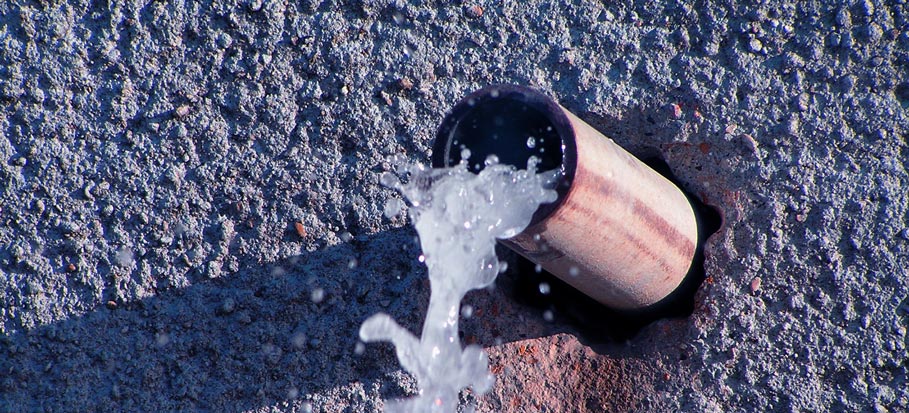We've noticed this great article pertaining to Leaking water lines down the page on the net and think it made sense to relate it with you in this article.

Early discovery of dripping water lines can mitigate a potential disaster. In addition to saving you cash, it will reduce the stress as well as disappointment. The moment you locate a leak, calling your plumber for repair services is the most effective remedy. Some tiny water leaks might not be visible. Here are some hacks that help if you can not find it with your naked eyes.
1. Check Out the Water Meter
Every home has a water meter. Examining it is a proven manner in which aids you discover leakages. For starters, turn off all the water sources. Make sure nobody will certainly flush, make use of the faucet, shower, run the cleaning device or dishwasher. From there, most likely to the meter and watch if it will change. Since no one is using it, there should be no movements. That shows a fast-moving leak if it relocates. If you find no changes, wait a hr or 2 and also check back once more. This suggests you might have a slow leak that could even be below ground.
2. Inspect Water Consumption
If you identify unexpected changes, regardless of your consumption being the same, it suggests that you have leaks in your plumbing system. An unexpected spike in your bill suggests a fast-moving leak.
A consistent rise every month, also with the exact same routines, shows you have a slow-moving leakage that's additionally slowly rising. Call a plumber to completely examine your building, especially if you really feel a cozy location on your flooring with piping underneath.
3. Do a Food Coloring Examination
When it comes to water usage, 30% comes from bathrooms. If the shade somehow infiltrates your bowl during that time without flushing, there's a leakage between the container and bowl.
4. Asses Exterior Lines
Do not fail to remember to check your outdoor water lines too. Test spigots by attaching a garden hose pipe. Ought to water leak out of the connection, you have a loosened rubber gasket. Change this and make sure all connections are limited. It will help get it properly analyzed and also preserved yearly if you have actually obtained a lawn sprinkler system. One small leak can waste lots of water and surge your water costs.
5. Evaluate the scenario and also check
Property owners must make it a practice to inspect under the sink counters and also even inside closets for any bad odor or mold development. These two red flags show a leak so timely interest is required. Doing regular inspections, even bi-annually, can save you from a significant problem.
Check for discolorations and compromising as a lot of devices as well as pipes have a life expectancy. If you suspect leaking water lines in your plumbing system, do not wait for it to intensify.
Early detection of dripping water lines can reduce a possible calamity. Some small water leaks might not be visible. Checking it is a proven method that helps you find leakages. One small leak can waste lots of water and also increase your water costs.
If you presume dripping water lines in your plumbing system, do not wait for it to intensify.
How to Know If Your Home Has a Hidden Leak
Water Meter Reveals Inexplicable Water Usage
If you’d like to test whether or not there’s a leak somewhere in your home, you can do this using your water meter. Here is how to conduct the test:
Don’t use any water in your home for at least 30 minutes; this also means not turning on faucets or water-using appliances.
Go outside, and check your water meter for activity.
If your water meter shows that there was activity, even though no one was using any water, this proves that there is a leak in your home.Visible Mold or Mildew Growth
Leaks behind walls create moist, dark environments that allow mold and mildew to grow and thrive. Eventually, you might see mold growth forming on the wall closest to a hidden leak.
If mold is growing in an area that receives a high amount of moisture, such as a bathroom, it may simply be an indication that better ventilation is needed. However, if you see mold growth on a wall or the ceiling in an area where you would not expect, you probably have a hidden leak.
Musty, Mildew Odor
Sometimes you might not be able to see the mold or mildew that is growing as a result of a leak. However, the smell can give the problem away just as easily. If you catch a whiff of something musty, there’s a good chance that old water is collecting somewhere in your home that you can’t see.
Stained/Warped Walls, Ceilings, or Floors
When your home soaks up water, a variety of red flags can become visible, including ceiling stains, bubbling drywall, warped walls, and sagging floors. While these issues can be caused by excess humidity, they can also be signs that a pipe or plumbing connection has started leaking behind your walls.
Inexplicably High Water Bill
After a while, you get a general sense for what your water bill should be. If you own a pool or sprinkler system, your bill will tend to be higher during summer. However, if you receive a water bill that seems especially high, and you can’t figure out what caused it, then you may have a hidden leak somewhere that’s increasing your bill.
https://www.plumbingjoint.com/blog/2019/july/how-to-know-if-your-home-has-a-hidden-leak/

As a reader on Detecting hidden plumbing leaks, I imagined sharing that piece of content was essential. Enjoyed our post? Please share it. Help other people discover it. Thank you so much for taking the time to read it.